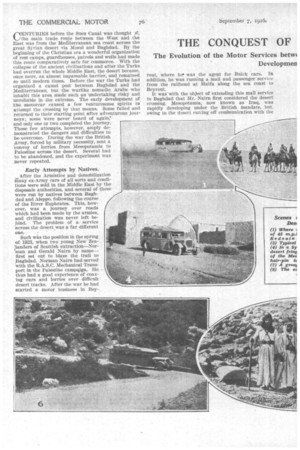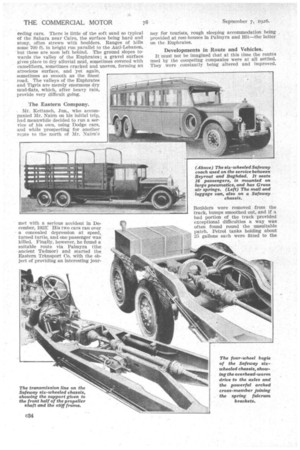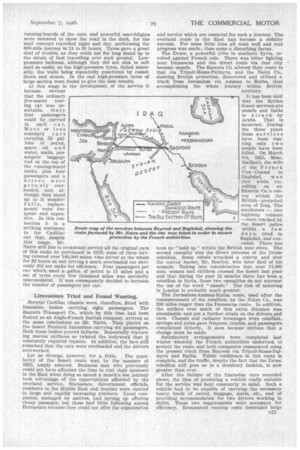THE CONQUEST OF 1E SYRIAN DESERT.
Page 54

Page 55

Page 56

Page 57

Page 58

If you've noticed an error in this article please click here to report it so we can fix it.
The Evolution of the Motor Services betw4 Developmen 3eyrout and Baghdad, and the Consequent the Traffic.
flENTURIES before the Suez Canal was thought )f,
the main trade route between the West and the East was from the Mediterranean sea coast across the great Syrian desert via Mosul and Baghdad. By the beginning of the Christian era a wonderful organization of rest camps, guardhouses, patrols and wells had made this route comparatively safe for commerce. With the collapse of the ancient civilizations and after the Turks had overrun the whole Middle East, the desert became, once more, an almost impassable barrier, and remained so until modern times. Before the war the Turks had organized a camel post between Baghdad and the Mediterranean, but the warlike nomadic Arabs who inhabit this area made such an undertaking risky and unreliable in the extreme. The early development of Mile motorcar caused a few venturesome spirits to attempt the crossing by that means. Some failed and returned to their starting point after adventurous journeys; some were never heard of again:, and only one or two completed the journey. These few attempts, however, amply demonstrated the dangers and difficulties to be overcome. During the war the British Army, forced by military necessity, sent a 'convoy of lorries from Mesopotamia to Palestine across the desert. Several had to be abandoned, and the experiment was never repeated.
Early Attempts by Natives.
After the Armistice and demobilization many ex-Army cars of all sorts and condi tions were sold in the Middle East by the disposals authorities, and several of these were run by natives between Baghdad and Aleppo, following the course of the River Euphrates. This,. however, was a journey over roads which had been made by the armies, and civilization was never left behind. The problem of a service across the desert was a far different one.
Such was the position iü the sprmg of 1923, when two young New Zealanders of Scottish extraction—Nor'man and Gerald Nairn by name— first set out to blaze the trail to Baghdad. Norman Nairn had served with the RA.S.C. Mechanical Transport in the Palestine cammign. He • thus had a good experience of coaxing cars and lorries over difficult desert tracks. After the war he had started a motor business in Bey rout, where heo was the agent for Buick cars. In addition, he was running a mail and passenger service from the railhead at Haifa along the sea coast to Beyrout.
It was-with the object of extending this mail service to Baghdad that Mr. Nairn first considered the desert crossing. Mesopotamia, now known as Iraq, was rapidly developing under the British mandate, but, owing to the desert cutting off communication with the
Mediterranean, Iraq had to look to the route via the Persian Gulf and India for supplies. It took 24 days for mails to reach Baghdad from London. Mr. Nairn at once grasped the possibilities of a new route to the East across the Syrian Desert bringing Baghdad within eight to ten days from Great Britain.
In April, 1923, the plans for the first trip were completed. Two Buick and two Dodge cars, standard in every way, were loaded up with spare petrol, oil and water, Camping equipment and food for several days were carried and, equipped with compasses and the best maps procurable, the party, which included Mr. Norman Nairn, Mr. Lovell (his head mechanic), Mr. liettaneh (the Beyrout representative of Thomas Cook and Son, Ltd.) and his son, who was' Dodge agent in Syria, set out on their adventurous journey. Fortune favoured these intrepid pioneers and although they met with many difficulties, Baghdad was reached four days later. It may have been that they were better equipped than their predecessors; their information and knowledge of the desert may have been greater ; certainly their luck held, and. it was a highly enthusiastic party which arrived at the ancient capital.
This trip proved the feasibility of crossing the desert on modern cars, given advantageous •circumstances, but to run a regular service as a commercial proposition to convey passengers, goods and mails, to cope with the blasting heat of the summer and the torrential winter rains, which turn the desert into a quagmire of liquid mud, was likely to be quite another matter.
A Regular Service Begun.
Further trial runs, equally successful, were made, however, in May, June, August and September. The possibilities of the desert route began to be realized, and a contract for the conveyance of. the British mails was given to Mr. Nairn, who had proceeded to America during the summer to order several. Cadillac .cars, which he considered would be suitable for the journey. At the end of October, 1923, a
regular weekly service was inaugurated by the Nairn Transport Co.
The authorities and merchants in Baghdad gave full support.
A description of the " road "
conditions might help to remove some of the misconceptions about this route. From Beyrout over the Lebanon mountains excellent roads are maintained ..by the French authorities. There are many severe gradients and. Sharp hair-pin bends until Damascus (65 miles) is reached. Around this city the country is highly cultivated, but alter about 25 miles cultivation abruptly gives place ta.barren desert, and the road, .which deteriorates considerably after leaving Damascus, comes to an end and is replaced by a desert track formed purely by the wheels of pre
ceding cars. There is little of the soft sand so typical of the Sahara near Cairo, the surface being hard and stony, often strewn with boulders. Ranges of hills some 700 ft. in height run parallel to the Anti-Lebanon, but these are soon left behind. The ground slopes towards the valley of the Euphrates; a gravel surface gives place to dry alluvial mud, sometimes covered with camelthorn, sometimes cracked and uneven, forming an atrocious surface, and yet again, sometimes as smooth as the finest road. The valleys of the Euphrates and Tigris are merely enormous dry mud-fiats, /which, after heavy rain, provide very difficult going.
The Eastern Company.
. Mr, Kettaneli, Jun., who accompanied Mr. Nairn on his initial trip, had meanwhile decided to run a service of his own, using Dodge cars, and while prospecting for another TO-Ute to the north of Mr. Nairn's
met with a serious accident in December, 1923: His two ears ran over a concealed depression at speed, turned turtle, and one passenger was killed. Finally, however, he found a suitable route via Palmyra (the ancient Tadmor) and started the Eastern Trhnsport Co. with the object of providing an interesting jour ney for tourists, rough sleeping accommodation being provided at rest-houses in Palmyra and Hit—the latter on the Euphrates.
Developments in Route and Vehicles.
It must not be imagined that at this time the routes used by the competing companies were at all settled. They were constantly being altered and improved.
Boulders were removed from the track, bumps smoothed out, and if a bad portion of the track provided exceptional difficulties a way was often found round the unsuitable Patch. Petrol tanks holding about 25 gallons each were fitted to the running-boards of the cars, and powerful searchlights were mounted to show the road in the dark, for the mail convoys travelled night and day, performing the 600-mile journey in 24 to 30 hours. Tyres gave a great deal of trouble, as they could not for long stand up to the strain of fast travelling over such ground. Lowpressure balloons, although they did not sink in soft mud so easily as the high-pressure tyres, failed miserably, the walls being repeatedly punctured by camelthorn and stones. In the end high-pressure tyres of -large section were found to give the best results. , At this stage in the development of the service it became obvious that the ordinary five-seater tour ing car was un suitable. Only
four passengers I P could be _carried in each c a r. More or less standard cars carrying 50 gallons of petrol, spare oil and
• water, mails, passengers' baggage tied on the top of the running-board tanks, plus four passengers and a driver, were gros sly overloaded, and, although they stood up to it wonderfully, replacements were frequent and expensive. In this connection it is a striking testimony to the Cadillac car that, despite this usage, Mr.
Nairn still has in occasional service all the original cars of this make he purchasedin 1923, some of them hav
ing covered over 140,000 miles. One driver at the wheel for 30 hours on end driving a much overloaded car obviously did not make for efficiency. Four passengers per
car which_ .uSed a gallon of petrol in 11 miles and a set of tyres every few thousand miles was decidedly uneconomical.It ivas consequently decided to increase the number of passengers per ear.
MEDITEPP CYPR u TRIPO 5EA s vEYRouf
HAIODAMA5Cu5
.AMMAN ALEP
HOM5
!JERusALEra 5
De5eF21 Limousines Tried and Found Wanting.
Several Cadillac chassis were, therefore, fitted with limousine bodies carrying eight passengers. The Eastern Transport Co., which by this time had been floated as an Anglo-French limited company, arrived at the same conclusions as Mr. Nairn. They placed on the desert Panhard limousines carrying six passengers. Both these bodies proved failures. Repeatedly traversing uneven surfaces so twisted the bodywork that it constantly required repairs. In addition, the fact still remained that the cars were overloaded and the drivers overworked.
Let us diverge, however, for a little. The popularity of the desert route was, by the summer of 1925, amply assured. Business men who previously could not have afforded the time to visit their interests in the East when doing so meant a month's sea journey took advantage of the opportunities afforded by the overland service. Statesmen, Government officials, residents in the Middle East and tourists were carried in large and rapidly increasing numbers. Local companies, managed by natives, had sprung up offering cheap passages, but these had little following among Europeans because they could not offer the organization and service which are essential for such a journey. The overland route to -the East had become a definite success. For some little time all went well and real progress was made; then came a disturbing factor.
The Druse, a powerful tribe in southern Syria, revolted against French rule. There was bitter fighting near Damascus and the direct route via that city became unsafe. The Eastern Co. altered their route to that via Tripoli-Homs-Palmyra, and the Nairn Co., desiring British protection, discovered and utilized a track from Jerusalem via Amman to Rutba, thus accomplishing the whole journey within British territory.
It has been said that the Syrian desert services are unsafe and liable to attack by Arabs. That is incorrect. During the three years these services have been running only two people have been killed. On March Sth, 1925, Mme. Mallard, the wife of the French Vice Consul in Baghdad, was shot while travelling on an Eastern Co.'s convoy within the British protected area of Iraq. The murderers — two highway robbers —were tracked by the desert police within a few days, tried in Baghdad, and executed. There has been no "hold up" within the British zone since. The second casualty was the direct outcome of the DruSe rebellion. Some rebels attacked a convoy and shot the convoy leader, Mr. Bentley, who later died of his wounds. Taking into consideration that over 11,000 men, women and children crossed the desert last year and that during the past 12 months there has been a rebellion in Syria, these two casualties do not warrant the use of the word "unsafe." The risk of motoring in London is probably much greater.
The Jerusalem-Amman-Rutba route, used after the commencement of the rebellion, by the Nairn Co., was 200 miles longer than the Damascus route. In addition, the surface over much of this extra distance was abominable and put a further strain on the drivers and cars. Chassis anti radiator breakages were constant, springs and axles gave frequent trouble, and passengers complained bitterly. It soon became obvious that a change must be made.
Satisfactory arrangements were completed last winter whereby the French authorities undertook to protect the route and both companies commenced using the present track from Beyrout via Tripoli-Horns-Palmyra and Ratba. Public confidence in this route is complete, and the traffic, despite the fact that the Drum rebellion still goes on in a desultory fashion, is now greater than ever.
After the failure of the limousine cars recorded above, the idea of producing a vehicle really suitable for the service was kept constantly in mind. Such a vehicle had to be capable of carrying the necessary heavy loads of petrol, baggage, mails, etc., and of providing accommodation for two drivers working in shifts. These two requirements were necessary for efficiency. Economical running costs demanded large
—.–, NAIRN'S DIPECT DAMASCUS POUTE ° PPESENT RoUTE
— THE OLD EASTERN OP ROUTE
\' Mr. Nairn visited America, and in conjunction with the Six-Wheel Co., of Philadelphia, evolved a likely design. The "Safeway" sixwheeler manufactured by this company has already b2en described in The Commercial Motor, but the main points in the design of this special car may be mentioned. Girder chassis construction was employed to obviate the torsional stresses which previously had proved so fatal to bodywork. An eight-speed gearbox with a low ratio of 50 to 1, 8-in. high-pressure tyres, a 130-gallon petrol tank, a six-cylinder Continental motor of 44-in, bore by 5i-in. stroke, developing 110 h.p., and special springing were embodied in the specification. A saloon body seating 16 passengers in padded armchairs and with lavatory accommodation was fitted. The experimental car was delivered in May of this year, thoroughly tested out on the desert, and was an emphatic success. Orders for four more of these cars with such detail improvements as seemed desirable have just been placed with the same company. Recently a strong combine has taken over both the Nairn Transport Co. and the Eastern Transport Co., which latter concern, owing to financial difficulties, had virtually ceased running. This new Anglo-French combine consists of the Anglo-Persian Oil Co., Ltd., the Ottoman Bank, the Imperial Bank of Persia, Stern Brothers of London, and the Banque de Paris at Pays Bas the Credit Franeaise d'Algerie, the Banque Ottoman and the Messageries Maritimes of Paris—a combine strong enough to lead one to expect great things in the future. It is gratifying to learn that Mr. Norman Nairn, whose indefatigable optimism and hard work have made the desert route a success, will be managing director in Beyrout. The ruins of the c36 At Damascus a garage is being erected which will include such modern plant as a quasi-arc electric welding outfit, a 200 lb. air com pressor, a spray-painting equipment, hydraulic jacks, overhead electric cranes, and electric lathes, grind ers, drills, valve grinders, hacksaws, vulcanizers and battery chargers. This garage will be in charge of Mr. E. A. Lovell, who ac companied Mr. ,Nairn on his first trip, and has proved a valuable ally. The new company ivill maintain and extend the service to Teheran inaugurated by the Eastern Transport Co. in the summer of 1924. The distance from Baghdad to Teheran is 600 miles, so that the total length of the route operated by the company will be 1,300 miles— surely a record in mechanical road transport. Baghdad to Teheran is a most enjoyable journey, particularly in the spring. The road, which was made by the British and Russian armies, is a wonderful feat of engineering. It crosses range after range of mountains, and traverses the famous Pytak and Assadabad Passes. reaching on the latter a height of nearly 10,000 ft. above sea level. The journey usually takes three to three-and-a-half days, and there is sleeping accommodation to be had in hotels at the towns of Kermanshah and Hamadan, where the nights are spent. In conclusion a word might well be said for the drivers. These men are weekly performing miracles. It is no mean undertaking to drive six or seven hundred miles without a rest even on good roads; it is a much harder job on the desert. Despite the summer heat—it was 127 in the shade a week or two ago—and the bitter cold of winter on the Lebanon mountains, they carry on without a grumble. When rain has turned the desert into a sea of liquid mud into which the cars sink to their running-boards, when fussy passengers become difficult to deal with and tyres give trouble, these men manage to remain cheerful. No position, however desperate, has proved too much for them. Their share in the success of the undertaking is a very real one. These British. drivers have a wonderful esprit de corps, and they are rightly proud of themselves, for few men could have done their job so well—none could have done it better. The whole enterprise forms a wonderful example of that tenacity of purpose for which the pioneers of our race are justly famed. Many of the difficulties encountered have been wellnigh insuperable, and some men, even well-hardened, might have been prepared to accept defeat without feeling cause for a loss of self-repect. This feat of conquering the difficulties and hardships of desert transport constitutes one more striking proof of the remarkable advances which are taking place throughout the world. The large passenger vehicle is proving its capabilities in no uncertain manner, and the development of the chassis with six or, perhaps, even more wheels is opening out a wonderful vista of possibilities for the future.Tags












































































































